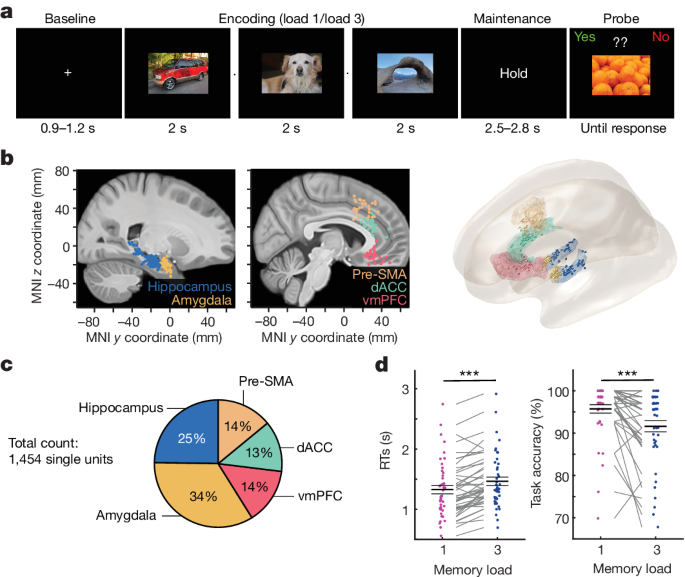insight - Neuroscience - # Theta-Gamma Phase-Amplitude Coupling in Human Hippocampus Regulates Working Memory Maintenance
Hippocampal Theta-Gamma Coupling Mediates Cognitive Control over Working Memory Representations in Humans
Core Concepts
Theta-gamma phase-amplitude coupling in the human hippocampus integrates frontal cognitive control and working memory storage, enabling higher-fidelity representations and improved behavioral performance.
Abstract
The article investigates how cognitive control mechanisms regulate the maintenance of information in working memory. The key findings are:
In the human hippocampus, theta-gamma phase-amplitude coupling (TG-PAC) was correlated with working memory load and quality.
The authors identified "PAC neurons" that selectively spiked during the nonlinear interaction of theta phase and gamma amplitude.
The spike timing of these PAC neurons was coordinated with frontal theta activity when cognitive control demand was high.
By introducing noise correlations with persistently active neurons in the hippocampus, PAC neurons shaped the geometry of the population code, leading to higher-fidelity representations of working memory content.
These higher-fidelity representations were associated with improved behavioral performance.
The results suggest that hippocampal TG-PAC integrates frontal cognitive control and working memory storage, providing a potential mechanism for top-down regulation of sensory-driven processes.
Control of working memory by phase–amplitude coupling of human hippocampal neurons - Nature
Stats
"Retaining information in working memory is a demanding process that relies on cognitive control to protect memoranda-specific persistent activity from interference."
"In the hippocampus, TG-PAC was indicative of working memory load and quality."
"The spike timing of these PAC neurons was coordinated with frontal theta activity when cognitive control demand was high."
"This led to higher-fidelity representations of working memory content that were associated with improved behaviour."
Quotes
"Our results support a multicomponent architecture of working memory1,2, with frontal control managing maintenance of working memory content in storage-related areas3,4,5."
"Within this framework, hippocampal TG-PAC integrates cognitive control and working memory storage across brain areas, thereby suggesting a potential mechanism for top-down control over sensory-driven processes."
Key Insights Distilled From
by Jona... at www.nature.com 04-17-2024
https://www.nature.com/articles/s41586-024-07309-z
Deeper Inquiries
How do the identified PAC neurons in the hippocampus interact with other neuronal populations to shape the population code and working memory representations?
The identified phase-amplitude coupling (PAC) neurons in the hippocampus play a crucial role in shaping the population code and working memory representations by coordinating with other neuronal populations. These PAC neurons selectively spike during nonlinear interactions of theta phase and gamma amplitude, indicating their involvement in encoding and maintaining working memory content. By introducing noise correlations with persistently active neurons in the hippocampus, PAC neurons influence the geometry of the population code. This results in higher-fidelity representations of working memory content, leading to improved behavioral outcomes. Therefore, the interaction of PAC neurons with other neuronal populations in the hippocampus helps in structuring and enhancing the encoding and maintenance of working memory representations.
What are the potential implications of disrupted theta-gamma coupling in the hippocampus for working memory deficits observed in neurological and psychiatric disorders?
Disrupted theta-gamma coupling in the hippocampus can have significant implications for working memory deficits observed in neurological and psychiatric disorders. Theta-gamma phase-amplitude coupling is crucial for coordinating interactions between frontal control and hippocampal persistent activity during working memory tasks. When this coupling is disrupted, it can lead to difficulties in maintaining and manipulating information in working memory. Patients with neurological or psychiatric disorders that exhibit disrupted theta-gamma coupling may experience impairments in working memory performance, such as reduced capacity, poor quality of memory representations, and increased susceptibility to interference. Understanding the impact of disrupted theta-gamma coupling on working memory deficits can provide insights into the underlying neural mechanisms of these disorders and guide the development of targeted interventions to improve working memory function.
Could the principles of theta-gamma coupling discovered in the human hippocampus be extended to understand the neural mechanisms of other cognitive functions, such as decision-making or episodic memory?
The principles of theta-gamma coupling discovered in the human hippocampus have the potential to be extended to understand the neural mechanisms of other cognitive functions, such as decision-making or episodic memory. Theta-gamma phase-amplitude coupling reflects a fundamental mechanism of neural communication and coordination, which is essential for integrating information across brain regions during cognitive processes. By applying similar principles of phase-amplitude coupling to different cognitive functions, researchers can investigate how neural oscillations facilitate communication between brain regions involved in decision-making, episodic memory encoding, and retrieval. Understanding how theta-gamma coupling influences these cognitive processes can provide valuable insights into the coordination of neural activity underlying complex behaviors and cognitive functions. Therefore, extending the study of theta-gamma coupling beyond working memory to other cognitive domains holds promise for uncovering general principles of neural communication and information processing in the brain.
0
